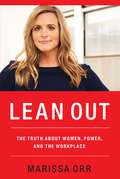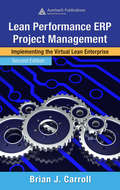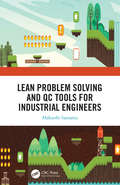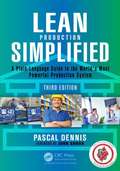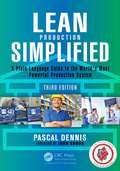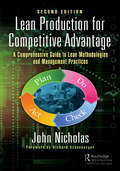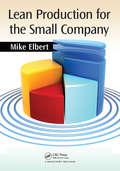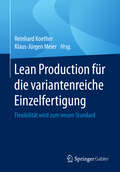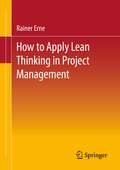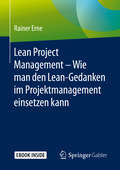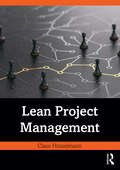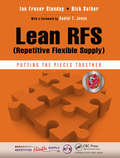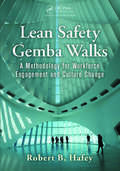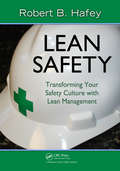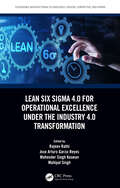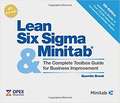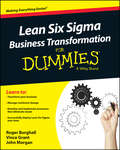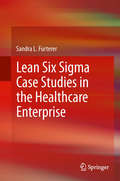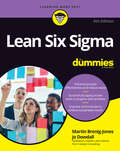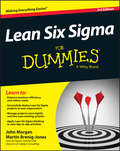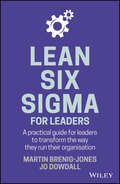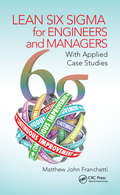- Table View
- List View
Lean Out: The Struggle For Gender Equality In Tech And Start-up Culture
by Elissa ShevinskyWhy aren't the great, qualified women already in tech being hired or promoted? Should people who don't fit in seek to join an institution that is actively hostile to them? Does the tech industry deserve women leaders? The split between the stated ideals of the corporate elite and the reality of working life for women in the tech industry--whether in large public tech companies or VC-backed start-ups, in anonymous gaming forums, or in Silicon Valley or Alley--seems designed to crush women's spirits. Corporate manifestos by women who already fit in (or who are able to convincingly fake it) aren't helping. There is a high cost for the generation of young women and transgender people currently navigating the harsh realities of the tech industry, who gave themselves to their careers only to be ignored, harassed and disrespected. Not everyone can be a CEO; not everyone is able to embrace a workplace culture that diminishes the contributions of women and ignores real complaints. The very culture of high tech, where foosball tables and endless supplies of beer are de facto perks, but maternity leave and breast-feeding stations are controversial, is designed to appeal to young men. Lean Out collects 25 stories from the modern tech industry, from people who fought GamerGate and from women and transgender artists who have made their own games, from women who have started their own companies and who have worked for some of the most successful corporations in America, from LGBTQ women, from women of color, from transgender people and people who do not ascribe to a gender. All are fed up with the glacial pace of cultural change in America's tech industry. Included are essays by anna anthropy, Leigh Alexander, Sunny Allen, Lauren Bacon, Katherine Cross, Dom DeGuzman, FAKEGRIMLOCK, Krys Freeman, Gesche Haas, Ash Huang, Erica Joy, Jenni Lee, Katy Levinson, Melanie Moore, Leanne Pittsford, Brook Shelley, Elissa Shevinsky, Erica Swallow, and Squinky. Edited and selected by entrepreneur and tech veteran Elissa Shevinsky, Lean Out sees a possible way forward that uses tech and creative disengagement to jettison 20th century corporate culture: ''I've figured out a way to create safe space for myself in tech,'' writes Shevinsky. ''I've left Silicon Valley, and now work remotely from home. I adore everyone on my team, because I hired them myself.
Lean Out: The Truth About Women, Power, and the Workplace
by Marissa OrrMore than fifty years since the passage of the Equal Pay Act, the wage gap still hovers at 80 percent. Half a billion dollars are spent annually on corporate diversity programs, yet only 5 percent of CEOs in the Fortune 500 are women. Lean Out is an ambitious attempt to answer the question few dare to ask: What have we gotten wrong about women at work? Based on in-depth research and personal experiences, Lean Out is inspired by the journey of Marissa Orr, a single mom of three trying to succeed in her fifteen-year career at the world’s top tech giants. In an eye-opening account, Orr exposes the systemic dysfunction at the heart of today’s most powerful corporations and how their pursuit to close the gender gap has come at the expense of female well-being. “Fewer women at the top is a clear signal that the system is broken,” says Orr. “With female-dominant strengths such as empathy and consensus-building being the future of business, the headlines forecast that women will dominate the future generations of corporate leaders. But that won’t happen until prescriptions for success stop requiring women to act more like men, mistaking traits such as empathy as signals of weakness.” Lean Out provides a new and refreshingly candid perspective on what it’s really like for today’s corporate underdogs, while challenging modern feminist rhetoric and debunking the belief that everyone has to be the same in order to be equal. Offering compelling new arguments for the reasons more women don’t make it to the top, Lean Out presents a revolutionary path forward, to change the life trajectories of women in the corporate world and beyond.
Lean Performance ERP Project Management: Implementing the Virtual Lean Enterprise, Second Edition (Resource Management)
by Brian J. CarrollLean thinking is too often narrowly focused on physical processes, causing serious shortcomings, which limit Lean‘s substantial benefits. Lean Performance ERP Project Management: Implementing the Virtual Lean Enterprise, Second Edition presents a lean business process design and implementation project management methodology that integrates strategy, people, process, information technology, and lean to manage the project implementation of the Virtual Lean Enterprise. This book uses a conversational tone to facilitate understanding of concepts. It demonstrates the need to connect Lean Performance with IT to achieve maximum lean benefits. It discusses the best business process methodologies and how to integrate them. The text also features a lean tool kit that requires participation from all departments of an organization.
Lean Problem Solving and QC Tools for Industrial Engineers
by Maharshi SamantaThe manufacturing and service sector needs to resolve a lot of issues relating to products, process and service in everyday operation. Successful resolution depends on the methodology, rigor and systematic implementation techniques. The essential purpose of this book is to impart the necessary knowledge to the reader about concepts in six sigma problem-solving providing sufficient knowledge of problem lifecycle and ways to address the various issues arising therein. The 7 QC tools and A3 strategy are described and analyzed in detail with various examples encompassing a step by step approach a professional must know to address a problem in an industrial engineering set up. Key Features Conceptualizes six sigmas problem-solving providing sufficient knowledge of problem lifecycle and ways to address the various issues for manufacturing industry professionals Enables effective use of 7 QC tools for solving problems Addresses the problem- solving part very specifically in all the contexts of PDCA cycle of improvement, DMAIC methodology of organizational transformation, and TPM & TQM culture of productivity and quality improvement Written with A3 theme throughout enabling each problem-solving tool to follow a structured approach Includes relevant and practical examples and applications
Lean Production Simplified: A Plain-Language Guide To The World's Most Powerful Production System
by Pascal DennisLean Production Simplified, Third Edition is a plain language guide to the Lean production system written for the practitioner by a practitioner. It delivers a comprehensive insider's view of Lean manufacturing. Organized around the image of the house of Lean production, the book helps the reader grasp both the system as a whole and the factors that animate it.
Lean Production Simplified: A Plain-Language Guide to the World's Most Powerful Production System
by Pascal DennisFollowing in the tradition of its Shingo Prize-winning predecessors, Lean Production Simplified, Third Edition gives a clear overview of the structure and tools of the Lean production system. Written for the practitioner by a practitioner, it delivers a comprehensive insider's view of Lean management. The author helps readers grasp the system as a
Lean Production for Competitive Advantage: A Comprehensive Guide to Lean Methodologies and Management Practices, Second Edition
by John NicholasThe second edition will include four new topics that fully address the scope of Lean: Hoshin Kanri (HK), Managing for Daily Improvement (MDI), Production Preparation Process (3P), and Lean in project management (especially for projects in product development). HK is a management planning process that evolved in Japan concurrent with Lean and early adopters employed it. MDI addresses the 5th S (sustain) in the 5S process. Together, HK and MDI answer questions such as: How is Lean tied to strategic planning? What is the role of management in Lean? How are daily improvements tied to organizational goals? and How are improvements sustained? The two topics address Lean as a "culture."
Lean Production for the Small Company
by Mike ElbertA hands-on guide to adapting Lean principles and the Toyota Production System to high-mix/low-volume environments, Lean Production for the Small Company uses charts, pictures, and easy-to-understand language to describe the methods needed to improve processes and eliminate waste. It walks readers through the correct order of implementation and desc
Lean Production für die variantenreiche Einzelfertigung
by Reinhard Koether Klaus-Jürgen MeierLean Production wurde für die Großserienfertigung entwickelt und ist zum weltweiten Standard geworden. Die Stückzahlen eines Produktes werden jedoch kleiner und die Vielfalt größer. Die Kunden erwarten maßgeschneiderte Lösungen zu Preisen wie aus der Massenfertigung. Dieses Buch zeigt anschaulich, welche Methoden aus der Lean Production genutzt bzw. modifiziert und welche nicht in die Kleinserienfertigung übernommen werden können. Dazu werden das Quick Response Management (QRM) und die aktuellen Entwicklungen von Industrie 4.0 mit der Lean Production verglichen und zu einem gemeinsamen Ansatz zusammengeführt. Konkrete Praxisbeispiele bieten Lösungsvorschläge.
Lean Production für die variantenreiche Einzelfertigung: Flexibilität wird zum neuen Standard
by Reinhard Koether Klaus-Jürgen MeierLean Production wurde für die Großserienfertigung entwickelt und ist zum weltweiten Standard geworden. Die Stückzahlen vieler Produkte werden jedoch kleiner und die Vielfalt größer. Die Kunden erwarten maßgeschneiderte Lösungen zu Preisen wie aus der Massenfertigung. Dieses Buch zeigt anschaulich, welche Methoden aus der Lean Production genutzt bzw. modifiziert in die Kleinserienfertigung übernommen werden können. Dazu werden das Quick Response Management (QRM) und die aktuellen Entwicklungen von Industrie 4.0 mit der Lean Production verglichen und zu einem gemeinsamen Ansatz zusammengeführt. Autoren aus Wissenschaft und industrieller Praxis bieten Lösungsvorschläge und zeigen konkrete Anwendungsbeispiele.Für die 2. Auflage wurden Inhalte aktualisiert und Fehler bereinigt.
Lean Project Management - How to Apply Lean Thinking to Project Management
by Rainer ErneThis book shows how the principles of Lean Management can be applied to project management and how some typical problems of project management can be solved by this. The author first provides a theoretical description of what project management is about and explains its tasks and methods as well as its limitations. He also describes how the Lean idea came about and derives five principles from it that can also be applied to project management. Along these principles, the author then elaborates typical current challenges of project management and shows how these challenges can be tackled through Lean Project Management. In doing so, he does not stop at the level of principles, but describes specific tasks and tools that are useful especially for experienced practitioners of project management. This book is a translation of the original German 1st edition Lean Project Management – Wie man den Lean-Gedanken im Projektmanagement einsetzen kann by Rainer Erne, published by Springer Fachmedien Wiesbaden GmbH, part of Springer Nature in 2019. The translation was done with the help of artificial intelligence (machine translation by the service DeepL.com). A subsequent human revision was done primarily in terms of content, so that the book will read stylistically differently from a conventional translation. Springer Nature works continuously to further the development of tools for the production of books and on the related technologies to support the authors.
Lean Project Management – Wie man den Lean-Gedanken im Projektmanagement einsetzen kann
by Rainer ErneDieses Buch zeigt, wie die Prinzipien des Lean Managements auf das Projektmanagement übertragen werden und wie einige typische Probleme des Projektmanagements damit gelöst werden können. Der Autor beschreibt zunächst theoretisch fundiert, worum es sich beim Projektmanagement handelt und erläutert dessen Aufgaben und Methoden sowie dessen Grenzen. Er beschreibt weiterhin, wie der Lean-Gedanke entstanden ist und leitet daraus fünf Grundsätze ab, die auch auf das Projektmanagement übertragbar sind. Entlang dieser Prinzipien beleuchtet der Autor anschließend typische aktuelle Herausforderungen des Projektmanagements und zeigt auf, wie diese Herausforderungen durch Grundsätze des Lean Project Managements bewältigbar sind. Dabei bleibt er nicht auf der Ebene von Grundsätzen stehen, sondern beschreibt konkrete Aufgaben und Werkzeuge, die vor allem für erfahrene Praktiker des Projektmanagements eine Hilfestellung sein sollen.
Lean Project Management: This Book Includes: Lean Guide + Agile Project Management. Practical Guide For Managing Projects, Productivity, Profits Of Enterprises Or Startups With Lean, Scrum, Agile
by Claus HüsselmannMany organisations face the challenge of making their project management more agile. However, the circumstances are often not suitable for this: The desired agility either does not fit the existing projects, or there is a lack of sufficient systematics. Lean Project Management shows how the advantages of different Lean Project Management methods – adaptive, targeted and flexible – can be combined. In addition to the established methods of classic and agile project management, proven methods and tools from Lean Management are used and further developed with a view to the requirements of project management (such as Gemba, 5S and more). The book shows how an organisation can systematically professionalise its project management, and make it more flexible in a targeted manner, in order to achieve more value with less effort. Aimed at students on postgraduate courses in business and project management as well as professional project managers working in organisations both large and small, Lean Project Management is a clear and comprehensive guide to combining the best methods to achieve optimal results.
Lean RFS (Repetitive Flexible Supply): Putting the Pieces Together
by Ian Fraser Glenday Rick SatherIs it possible to be repetitive and flexible at the same time? Using proven examples and quantifiable evidence, Lean RFS (Repetitive Flexible Supply): Putting the Pieces Together demonstrates that repetitive flexible supply (RfS) is not only possible, but that its implementation can help you reach a new level of improved performance in manufacturin
Lean Safety Gemba Walks: A Methodology for Workforce Engagement and Culture Change
by Robert B. HafeyA Lean Safety Gemba Walk is a walk through the work area (Gemba) that focuses on the continuous improvement of safety. When conducted in a respectful manner, by skilled facilitators, Safety Gemba Walks can have a dramatic long-lasting impact on the culture of a business. Lean Safety Gemba Walks: A Methodology for Workforce Engagement and Culture Ch
Lean Safety: Transforming your Safety Culture with Lean Management
by Robert HafeyWhile worker safety is often touted as a company�s first priority, more often than not, safety activity is driven by compliance to legislation rather than any safety improvement initiative. Lean takes a proactive approach � it is not contingent on legislation. A serious Lean effort will tear apart an old inefficient entitlement-riddled culture and
Lean Six Sigma 4.0 for Operational Excellence Under the Industry 4.0 Transformation (Sustainable Manufacturing Technologies)
by Rajeev Rathi Mahender Singh Kaswan Mahipal Singh Arturo Garza-Reyes, JoseThis book presents innovative breakthroughs in operational excellence that can solve the operational issues of smart factories. It illustrates various tools and techniques of Lean Six Sigma 4.0 and details their suitability for manufacturing and service systems. Lean Six Sigma 4.0 for Operational Excellence Under the Industry 4.0 Transformation provides technological advancement in operational excellence and offers a framework to integrate Lean Six Sigma and Industry 4.0. The book is a guide to dealing with new operational challenges and explains how to use Industrial IoT, Sensors, and AI to collect real-time data on the shop floor. While focusing on developing a toolset for Lean Six Sigma 4.0, this book also presents the enabling factors to adopt Lean Six Sigma 4.0 in the manufacturing and service sectors. The book will help industrial managers, practitioners, and researchers on the path of process improvement in modern-day industries.
Lean Six Sigma And Minitab: The Complete Toolbox Guide For Business Improvement
by Quentin BrookLean Six Sigma and Minitab: The Complete Toolbox Guide for Business Improvement
Lean Six Sigma Business Transformation For Dummies
by John Morgan Roger Burghall Vince GrantUse Lean Six Sigma to transform your business. Lean Six Sigma is a powerful method for improving both the efficiency and quality of projects and operations. In this new book, the team that bought you Lean Six Sigma For Dummies shows you how to take Lean Six Sigma to the next level and manage continual change in your organization. You'll learn to design a roadmap for transformation that's tailored to your business objectives; develop and implement processes that eliminate waste and variation across the company; synchronize your supply chain; and successfully deploy Lean Six Sigma over time. Lean Six Sigma Business Transformation For Dummies shows you how to: Define your transformation objectives and create a bespoke 'Transformation Charter' for your organization. Assess your company's readiness for transformation. Establish a 'Transformation Governance System' to help you manage the transformation programme effectively. Bring your people with you! Plan and achieve the cultural change needed to make the transformation process successful. Join up the dots between planning and effective execution with Strategy Deployment. Deploy a 'Continuous Improvement' toolkit to achieve everyday operational excellence. Sustain the transformation programme and widen the scope across the organization (including deploying to the supply chain). Adopt a 'Capability Maturity Approach' to drive business improvement – recognizing that change is a continuous transformational journey, just as pioneers like Toyota have done. Use a range of Lean Six Sigma Tools – using the right tools, at the right time (and in the right order!) enables continuous improvement by eliminating waste and process variation.
Lean Six Sigma Case Studies in the Healthcare Enterprise
by Sandra L. FurtererThis book provides a detailed description of how to apply Lean Six Sigma in the health care industry, with a special emphasis on process improvement and operations management in hospitals. The book begins with a description of the Enterprise Performance Excellence (EPE) improvement methodology developed by the author that links several methodologies including systems thinking, theory of constraints, Lean and Six Sigma to provide an enterprise-wide prioritization and value-chain view of health care. The EPE methodology helps to improve flow at the macro or value-chain level, and then identifies Lean Six Sigma detailed improvements that can further improve processes within the value-chain. The book also provides real-world health care applications of the EPE and Lean Six Sigma methodologies that showed significant results on throughput, capacity, operational and financial performance. The Enterprise Performance Excellence methodology is described, and also the Six Sigma DMAIC (Define-Measure-Analyze-Improve-Control) problem solving approach which is used to solve problems for health care processes as they are applied to real world cases. The case studies include a wide variety of processes and problems including: emergency department throughput improvement; operating room turnaround; operating room organization; CT imaging diagnostic test reduction in an emergency department; linen process improvement; implementing sepsis protocols in an emergency department; critical success factors of an enterprise performance excellence program.
Lean Six Sigma For Dummies
by Martin Brenig-Jones Jo DowdallBecome a process improvement star with Lean Six Sigma! Thinking Lean? Not in terms of weight loss, but operational efficiency? Then you can get into the Lean mindset with Lean Six Sigma For Dummies. A popular process improvement strategy used in many corporations, Lean Six Sigma exemplifies eliminating waste and optimizing flow at an operational level. With the strategies outlined in this book, you’ll have your projects, team, and maybe even your organization running at peak efficiency. Written by two experts that have been teaching Lean Six Sigma for over 20 years, Lean Six Sigma For Dummies explains the jargon surrounding this organizational practice, outlines the key principles of both Lean thinking and the Six Sigma process, and breaks it all down into easy-to-follow steps. Use Lean Six Sigma to develop a culture of continuous improvement Complete repetitive tasks through robotic process automation Assess how well your company and employees adapt to Lean Six Sigma Discover tips on how to implement Lean Six Sigma every day Find best practices to sustain ongoing improvements With handy checklists and helpful advice, Lean Six Sigma For Dummies shows you how to implement Lean Six Sigma in any industry, within any size organization. Pick up your copy to successfully lean into the Lean Six Sigma mindset yourself.
Lean Six Sigma For Dummies
by John Morgan Martin Brenig-JonesMaximise the quality and efficiency of your organisation with Lean Six Sigma Are you looking to make your organisation more effective and productive? If you answered "yes," you need to change the way it thinks. Combining the leading improvement methods of Six Sigma and Lean, this winning technique drives performance to the next level—and this friendly and accessible guide shows you how. The third edition of Lean Six Sigma For Dummies outlines the key concepts of this strategy and explains how you can use it to get the very best out of your team and your business. The jargon-crowded language and theory of Lean Six Sigma can be intimidating for both beginners and experienced users. Written in plain English and packed with lots of helpful examples, this easy-to-follow guide arms you with tools and techniques for implementing Lean Six Sigma and offers guidance on everything from policy deployment to managing change in your organisation—and everything in between. Gives you plain-English explanations of complicated jargon Serves as a useful tool for businesspeople looking to make their organisation more effective Helps you achieve goals with ease and confidence Provides useful hands-on checklists Whether you want to manage a project more tightly or fine-tune existing systems and processes, the third edition of Lean Six Sigma For Dummies makes it easier to achieve your business goals.
Lean Six Sigma For Leaders: A practical guide for leaders to transform the way they run their organisation
by Martin Brenig-Jones Jo DowdallA refreshingly practical guide to real-world continuous improvement Lean Six Sigma for Leaders presents a no-frills approach to adopting a continuous improvement framework. Practical, down-to-earth and jargon-free, this book outlines the basic principles and key points of the Lean Six Sigma approach to help you quickly determine the best course for your company. Real-world case studies illustrate implementation at various organisations to show you what went right, what went wrong, what they learned and what they would have done differently, giving you the distilled wisdom of hundreds of implementations with which to steer your own organisation. Written from a leader's perspective, this quick and easy read presents the real information you need to make informed strategic decisions. While many organisations have implemented either Lean or Six Sigma, there is a growing interest in a combined approach; by implementing the most effective aspects of each, you end up with a more potent, adaptable system that benefits a wider range of organisations. This book shows you how it works, and how to tailor it to your organisation's needs.
Lean Six Sigma Secrets for the CIO
by Peter T. Davis William BentleyGoing beyond the usual how-to guide, Lean Six Sigma Secrets for the CIO supplies proven tips and valuable case studies that illustrate how to combine Six Sigma's rigorous quality principles with Lean methods for uncovering and eliminating waste in IT processes. Using these methods, the text explains how to take an approach that is all about im
Lean Six Sigma for Engineers and Managers: With Applied Case Studies
by Matthew John FranchettiThis book introduces Lean Six Sigma (LSS) to engineers and managers interested in implementing LSS at their organizations. The book provides a detailed roadmap and industry examples to aid readers in understanding and implementing the LSS system. This book discusses the LSS process to define improvement needs, measure current business performance, analyze performance results using statistical tools, improve business and financial results, and control peak business performance.

